The Marine Elf Nemo Family-- A complete Collection of the Culture of "Clownfish"
Clown fish is a common name for the fishes of the subfamily Sparidae, which is a kind of tropical saltwater fish. It is known that there are 28 species, one from Premnas and the other from Amphiprion. Clown fish and sea anemone have a close symbiotic relationship, so it is also called sea anemone fish. The poisonous anemone protects the clown fish, while the clown fish eats the digested residue of the anemone, forming a mutually beneficial symbiotic relationship.

The clown fish has a maximum body length of 11cm. The total number of dorsal spines is 10: 12; the total number of dorsal soft strips is 4: 16; the total number of gluteal spines is 2; the total number of anal fin soft strips is 14: 15, all juveniles are black with scales concentrated blue; white patches on the forehead and upper side; all fins are black except the outer part of the pectoral and soft dorsal fins. The geography of the adult fish and the behavior color is variable.

Clownfish are not the only hermaphrodites, but they are one of the few species in which males can become and females cannot become males. Each clown fish population has a dominant female and several adult males, who are hermaphroditic in adolescence. If the dominant female dies, one of the adult males will undergo hormonal changes and become the new female in the population. During the spawning period, male and female fish have the domain behavior of protecting nests and eggs. One end of the egg will be fixed to a stone and hatched for a week or so, and the young fish will float in the water for a period of time before they inhabit symbiotic organisms such as sea anemones. Because there are one or two white stripes on their faces, like clowns in Beijing Opera, they are commonly known as "clown fish".
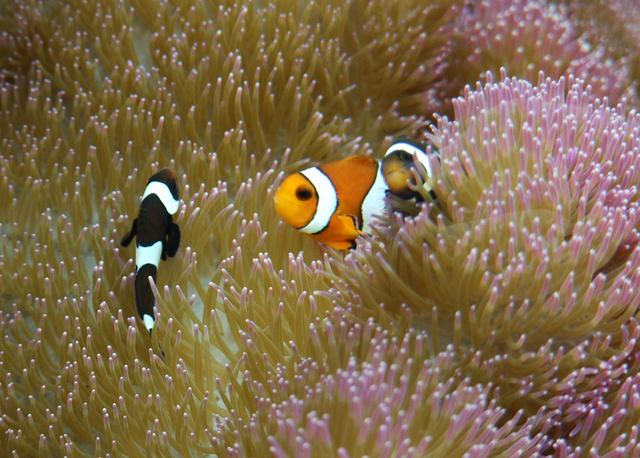
Environment: reef fish; non-migratory; non-migratory; ocean; upper and lower limit of depth 1m-55m
Climate: tropical; between 25 degrees N and 35 degrees S.
Importance: fishery, low economy; aquarium, commercial.
Resilience: height, population doubling time less than 15 months
Biology: inhabiting coral reefs and reefs, juvenile fish often symbiosis with large sea anemones, sea urchins or small coral tops. Form small to large schools of fish with stomach contents including algae, copepods, and other planktonic crustaceans.
Mode of reproduction: egg placement.
Diet: omnivorous.
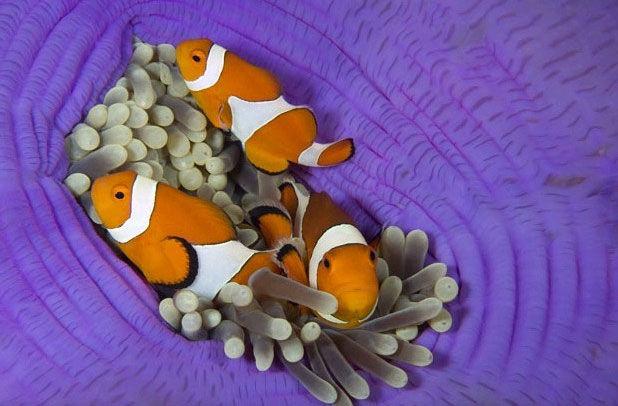
Clownfish are native to warmer waters in the Indian and Pacific oceans, including the Great Barrier Reef and the Red Sea. Although the distribution of most species has its limitations, some of them are widely distributed. Clown fish live in shallow lagoons or coral reefs at the bottom of shallow waters. Indo-Pacific Ocean, Red Sea, north to southern Japan, south to Australia, Sydney and so on.
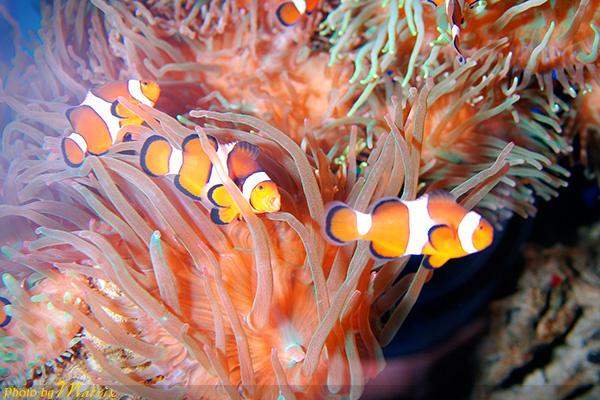
The clown fish has special mucus on its body surface, which can protect it from the influence of sea anemones and live safely and freely. Because of the protection of the sea anemone, the clown fish can be protected from other big fish. At the same time, the leftover food of the sea anemone can also be supplied to the clown fish, and the clown fish can also use the tentacles of the sea anemone to build nests and lay eggs. For sea anemones, the free entry and exit of clown fish can attract other fish and increase the chance of predation; clown fish can also remove the necrotic tissue and parasites of sea anemones, and because the swimming of clown fish can reduce the deposition of debris into sea anemones. Clown fish can also remove parasites or mold from their bodies by rubbing between the tentacles of sea anemones.
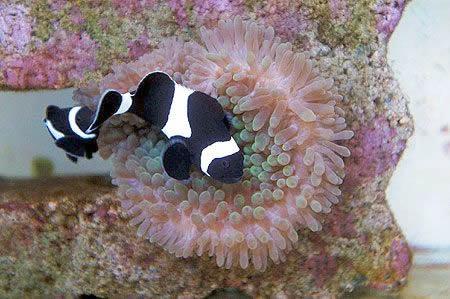
Clown fish lay eggs in the tentacles of sea anemones. After hatching, the young fish live in the water for a period of time before they begin to choose groups of anemones suitable for their growth. After adaptation, they can live together. It is worth noting that clown fish can not live in every kind of sea anemone, but only in specific objects, while clown fish can still survive without sea anemones, but lack protection.
Clownfish are very domain-minded, and usually a pair of male and female fish occupy a sea anemone to prevent other species from entering. If it is a large sea anemone, they will also allow other young fish to join in. In such a large family, the strongest is the female, she and her mate, the male, dominate, and the other members are males and young fish that have not yet shown their characteristics. Females chase and oppress other members so that they can only move in unimportant corners around the sea anemones. If the female fish in charge disappears, the male of the original couple will become a female within a few weeks, with full female physiological function, and then take longer to change external characteristics, such as body shape and color, and finally completely become a female, while one of the other males will produce the strongest one to become her mate.
Ha ha! All right, let's introduce you to these clown fish.
Childe clown fish
Scientific name: amphiprion ocellaris
Distributed in the reef waters of the South China Sea, the Philippines and the western Pacific Ocean, the body length is 10~12cm, oval. The body color is orange, and there are three silver-white bands on the side of the body, which are located behind the eyes, the center of the dorsal fin and the caudal handle, in which the leucorrhea in the center of the dorsal fin forms a triangle on the side of the body, and each fin has a black edge. The feeding water temperature is 26 ~ 27 ℃, the specific gravity of sea water is 1.022 ~ 1.023, the ph value of sea water is 8.0 ~ 8.5, and the hardness of sea water is 7 ~ 8 dh. The bait is rich shrimp, seaweed, chopped fish, pellet feed and so on. It likes to hide in the sea anemone, protect itself with its prickly cells and form a symbiotic relationship with the sea anemone.
Red clown fish
English name: red clown
Common name Tomato (Hong Kong)
English name: Tomato Clownfish, Red Clown, Tomato Anemonefish
Latin scientific name: Amphiprion frenatus
Named by year: Brevoort
Distribution: from the Gulf of Thailand to the southwest of Palau, to southern Japan in the north, and to Java in Indonesia in the south.
Climatic zone: tropical, between 25 degrees N and 35 degrees S
Features: the soft strip is square and elongated; the adult fish is black with red fins on the head, chest, abdomen and body. There is a wide leucorrhea with white margin at the back of the eye, extending downward to the laryngeal isthmus. The adult fish has a uniform orange-yellow body with a white vertical band behind the eyes. With the growth, the body color gradually turns red, and black spots appear at the back of the body and spread to the whole body.
Habits: living in lagoons and bays between 1 to 12 meters deep, symbiotic with pacifier corals (Entacmaea quadricolor).
Red clown is a common fish species, the price is cheap, pay attention to the difference with the Indian red clown (Amphiprion ephippium) when buying. The biggest difference between the red clown and the Indian red clown (Amphiprion ephippium) is that the Indian red clown has no white vertical band behind the eyes of the adult fish and is easy to identify.
Black double belt clown fish
Scientific name: amphiprion sebae
Distributed in the coral reef area of the Indian Ocean, belonging to the family Sparidae, body length 10~15cm, oval. The whole body is purple-black, and there are three silver-white vertical bands on the side behind the eyes, the middle of the dorsal fin and the tail handle, the mouth is silver-white, and there is a black belt through the eyes. The feeding water temperature is 26 ~ 27 ℃, the specific gravity of sea water is 1.022 ~ 1.023, the ph value of sea water is 8.0 ~ 8.5, and the water hardness is 7 ~ 9 degrees dh. The water quality is required to be clarified, and the bait includes harvest shrimp, fish and insects, chopped fish and shrimp meat, sea water fish pellet feed and so on. I like to hide in the tentacles of flowering sea anemones.
Red clown fish
Scientific name: PREMNAS BIACULEATUS
Distributed in the coral reef waters of the Indian Ocean and Pacific Ocean, belonging to the family Sparidae, body length 10~15cm, oval. The body is purple-black, each fin is purple-red, and there are three silver-white bands on the side of the body behind the eyes, the middle of the dorsal fin and the tail handle, which is very beautiful. The water temperature is 2627 ℃, the specific gravity of sea water is 1.022-1.023, the ph value of seawater is 8.0-8.5, and the hardness of water is 7-9 degrees dh.
The bait includes algae in seawater, animal plankton, pellet feed for marine fish and so on. Most of the red clowns are raised in the aquarium with invertebrates, perched in the tentacles of slightly shaking sea anemones, charming and gorgeous.
Red double belt clown fish
Scientific name: amphiprion clarkii
The red double-belt clown fish is distributed in the coral reefs of the Indian Ocean and Pacific Ocean, Taiwan, South China Sea and the Philippines. It belongs to the family Sparidae, with a body length of 10~12cm and an oval shape. The whole body is bright red, with two silver bands on the side behind the eyes and in the middle of the dorsal fin. The body color of the double-belt clown is varied, such as bright red, purple and black, etc., the water temperature is 2627 ℃, the specific gravity of sea water is 1.022-1.023, the ph value of seawater is 8.0-8.5, and the hardness of water is 7-9 degrees dh. The bait includes marine fish pellet feed, chopped fish meat, seaweed and so on. The water quality requires clarification and likes to hide in colorful sea anemones.
Coffee clown fish
Scientific name: amphiprion perideraion
Distributed in the coral reef waters of the Philippines, Taiwan and the Pacific Ocean, belonging to the family Sparidae. Body length 5~8cm, oval. The whole body is light brown, and there is a white band behind the eyes, just like a silver ring around the neck. The mouth is silvery white, from the mouth along the back to the caudal stalk and the dorsal fin. The feeding water temperature is 26 ~ 27 ℃, the specific gravity of sea water is 1.022 ~ 1.023, the ph value of sea water is 8.0 ~ 8.5, and the hardness of seawater is 7 ~ 8 dh. Bait has algae, fish and insects, harvest shrimp, marine fish pellet feed and so on.
Like to live in sea anemones or corals. The mucus secreted on the surface of the clown fish protects itself from the stinging cells of the sea anemone. it hides in the flower-like tentacles of the sea anemone and forms a symbiotic relationship with the sea anemone.
Black Panther clown fish
English name: black Panther clown
Panther clown
Common name: broadband clown (Taiwan)
English name: Wide-band Anemonefish Latin name: Amphiprion latezonatus
Geographical distribution: the range of distribution is only in the waters of Australia and New Caledonia.
Climatic zone: subtropical, between 25-32 degrees south
Features
Morphological features: dorsal fin spine (total): 10 eyes large, upper lateral position. The mouth is large and the end of the maxilla is less than the anterior margin; the teeth are uniseriate and the tooth ends are notched. The dorsal fin is single, and the soft strip is elongated and obtusely round. The adult fish body is brown-black to black, and the snout is white. There is a leucorrhea with a black edge at the back of the eye and a large trapezoidal white spot on the back of the body, so it is also named "broadband clown", and there is another broad white band on the tail handle. The fins of the body are consistent with the body color.
Body size: maximum body length 14cm
Habits: living in reef areas and coastal reef areas between 10-45 meters deep, symbiotic with purple anemone (Heteractis crispa).
Indian Red Clown
English name: Saddle Anemonefish
Latin scientific name: Amphiprion ephippium
Named by, year: Bloch,1790
Distribution: coral reefs in the eastern Indian Ocean, including the Andaman and Nicobar Islands (Nicobar Islands), Thailand, Malaysia and Java and Sumatra (Sumatra) in Indonesia.
Climatic zone: tropical, between 15 degrees N and 11 degrees S
Features: dorsal fin spines (total): 1011
The soft strips of adult fish are elongated and square; the adult body is red to brown, the side of the body is black, and the fins of the body are red to brown. The juvenile fish is red with a narrow white vertical band behind the eyes, which extends only downward to the edge of the Gill operculum, and there is an inconspicuous to black plaque on the upper side of the body. With the growth, the leucorrhea gradually disappeared, while the black spots gradually expanded to the whole body. The biggest difference between the Indian red clown and the red clown (Amphiprion frenatus) is that the red clown has a wide white vertical band with a black edge behind the eyes of the adult fish, which extends down to the laryngeal isthmus, making it easy to identify.
Body size maximum body length 14cm
Biometrics: inhabit muddy coastal bays at depths of 2 to 15 meters, usually in pairs where visibility is low.
Add that Indian Amphiprion frenatus is a common fish species, the price is cheap, pay attention to the difference with the Red Clown (Red Clown).
Silver thread clown
English name: Skunk Clownfish
Latin scientific name: Amphiprion akallopisos
Named by, year: Bleeker,1853
Distribution: it covers East Africa, Madagascar, Comoros (Comoro Islands), Seychelles, Andaman Sea, Sumatra (Sumatra, west of Indonesia) and Kuril Islands (Seribu Islands, Java Sea). No sign of it was found in Maldives or Sri Lanka. The Pacific Silver Line Clown (Amphiprion sandaracinos), an ethnic group in the western Pacific, is very similar and is often confused.
Climatic zone: tropical, between 23 degrees N and 35 degrees S
Body size: maximum body length 11cm
Habits: inhabit shallow coastal coral reef areas with a depth of 3 to 25 meters, usually living in strong current areas with a depth of about 15 meters. Each anemone is captured by a larger female, along with a smaller functional male (functional male, meaning a fish that only provides male functions but whose sex is not permanent, because it can change its sex as needed) and several young fish whose growth is hampered. If the female is driven away or leaves on her own, the functional male will be transformed into a female, and the largest juvenile will assume the role of functional male over and over again.
Biometrics: dorsal fin spines (total): 8: 9 dorsal fin strips (total): 17: 20 anal fin spines: 2 anal fin spines: 12: 14
The soft strips of adult fish are elongated and obtusely round; the adult body is uniform orange, with a white band from the back of the head and back to the top of the caudal stalk, the soft strips of the dorsal fin are white or yellow, and the remaining fins are consistent with the body color. The Indian Ocean Silver Joker is very similar to the Pacific Silver Joker (Amphiprion sandaracinos) except that the leucorrhea of the latter extends back from the upper lip, while the upper lip of the former is consistent with the body color and is not difficult to tell.
The reproduction of clown fish
First of all, it is necessary to have a more suitable cylinder, in which to put a few more living rocks, there should be a certain place of shelter, that is, the role of barrier. It is best to put a pebble in this escape cave, outside the mouth of the cave, where the pebbles are attached, and a larger sea anemone, which is best able to cover the whole hole or cover the pebbles when you grow up. It is recommended to choose a large carpet sea anemone, or a princess sea anemone, so that the clown has sense of security. In addition, the hole should also ensure that there is a suitable flow of water through.
The next step is to choose the clown, it is recommended to choose the smaller male fish, the general red clown male fish is bright red, choose 1 Mel 2. Then choose to remind larger, abdominal gonadal mature female fish, the general red clown female is dark red, 4 Mel 5. Keep them together for a period of time and observe the pairing.
In general, most of the matched clowns are a couple cooped up in a sea anemone, while other clowns are driven aside. If you find this at this time, you can remove the other clowns. Pay attention to the regular feeding of clown couples and pay attention to nutritional matching. VG- microbial nourishing agents can be mixed with vitamin E in their bait.
During the period of clown fish spawning, the phenomena that occur are:
The main results are as follows: 1. when the gonads of female and male fish mature, the mating period of male fish and the fallopian tube of female fish will be prominent.
2. When the day of spawning is approaching, the clown couple will take the initiative to tidy up the environment of their love nest and use their mouth to sweep away algae, gravel and so on. Ha ha
3. Clown fish usually spawn in the afternoon or near evening, about 2 hours, and the number of eggs laid each time is hundreds to thousands.
4. After the female fish spawn, the male fish will release sperm immediately and alternately until the end of spawning.
5. the fertilized egg has a transparent adventitia and an orange yolk.
6. In the process of clown eggs hatching, the clown couple will blow each other by mouth or through the pectoral fin and caudal fin to get out the dirt on the eggs, so that the eggs are fully exposed to oxygen, and the males are generally more diligent in the later stage.
7. The eyes in the oocyst can be clearly seen in about 10 days, and they can be hatched in 14 days.
8. After hatching, the small fish is very fragile and has a strong ability to avoid light, so it is necessary to leave his parents and avoid the current, but adhere to the regular change of water, pH and temperature should be stable.
9. Hatched fish can be fed with rotifer and VG once a day. After 5 days, rotifers and newly hatched shrimp can be fed twice a day. After 15 days, you can feed the harvest shrimp alone, and a month later, you can feed a small amount of clam meat.
As long as you give the clown a good environment, as the saying goes, "full of warmth and lust", take good care of, natural reproduction will be fine. I hope everyone's clowns will be full of children and grandchildren!
Ha ha! All right, that's all for today's clown fish!
If you still want to see it, remember to leave a message for the editor.
Follow the editor and learn a little every day! (^-^) V
- Prev
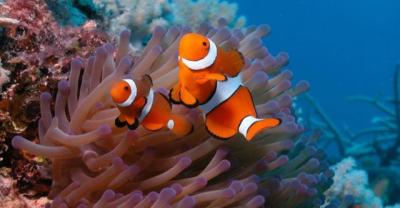
The breeding methods and points for attention of Ling Arrow Lotus, the succulent plant "Huatian Encyclopedia"
Make arrow lotus growth habits make arrow lotus, like warm and humid environment, avoid direct sunlight, drought, semi-shade, afraid of rain, fertile, loose,.
- Next

Ecological Disease Prevention and Culture techniques of floating Grass bed in Freshwater Pond
In order to control the occurrence of diseases, save water resources, improve the comprehensive three-dimensional and efficient utilization of ponds, and promote the development of healthy aquaculture, we have been in freshwater ponds in recent years.
Related
- On the eggshell is a badge full of pride. British Poultry Egg Market and Consumer observation
- British study: 72% of Britons are willing to buy native eggs raised by insects
- Guidelines for friendly egg production revised the increase of space in chicken sheds can not be forced to change feathers and lay eggs.
- Risk of delay in customs clearance Australia suspends lobster exports to China
- Pig semen-the Vector of virus Transmission (4)
- Pig semen-the Vector of virus Transmission (3)
- Five common causes of difficult control of classical swine fever in clinic and their countermeasures
- Foot-and-mouth disease is the most effective way to prevent it!
- PED is the number one killer of piglets and has to be guarded against in autumn and winter.
- What is "yellow fat pig"? Have you ever heard the pig collector talk about "yellow fat pig"?

